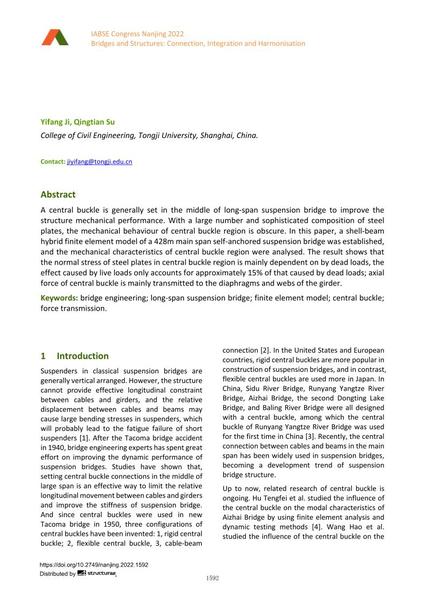Mechanical Analysis of Central Buckle Region of Long Span Suspension Bridge

|
|
|||||||||||
Bibliografische Angaben
| Autor(en): |
Yifang Ji
(College of Civil Engineering, Tongji University, Shanghai, China.)
Qingtian Su (College of Civil Engineering, Tongji University, Shanghai, China.) |
||||
|---|---|---|---|---|---|
| Medium: | Tagungsbeitrag | ||||
| Sprache(n): | Englisch | ||||
| Tagung: | IABSE Congress: Bridges and Structures: Connection, Integration and Harmonisation, Nanjing, People's Republic of China, 21-23 September 2022 | ||||
| Veröffentlicht in: | IABSE Congress Nanjing 2022 | ||||
|
|||||
| Seite(n): | 1592-1599 | ||||
| Anzahl der Seiten (im PDF): | 8 | ||||
| DOI: | 10.2749/nanjing.2022.1592 | ||||
| Abstrakt: |
A central buckle is generally set in the middle of long-span suspension bridge to improve the structure mechanical performance. With a large number and sophisticated composition of steel plates, the mechanical behaviour of central buckle region is obscure. In this paper, a shell-beam hybrid finite element model of a 428m main span self-anchored suspension bridge was established, and the mechanical characteristics of central buckle region were analysed. The result shows that the normal stress of steel plates in central buckle region is mainly dependent on by dead loads, the effect caused by live loads only accounts for approximately 15% of that caused by dead loads; axial force of central buckle is mainly transmitted to the diaphragms and webs of the girder. |
||||
| Stichwörter: |
Finite-Elemente-Modell weitgespannte Hängebrücke
|
||||
| Copyright: | © 2022 International Association for Bridge and Structural Engineering (IABSE) | ||||
| Lizenz: | Die Urheberrechte (Copyright) für dieses Werk sind rechtlich geschützt. Es darf nicht ohne die Zustimmung des Autors/der Autorin oder Rechteinhabers/-in weiter benutzt werden. |
||||

